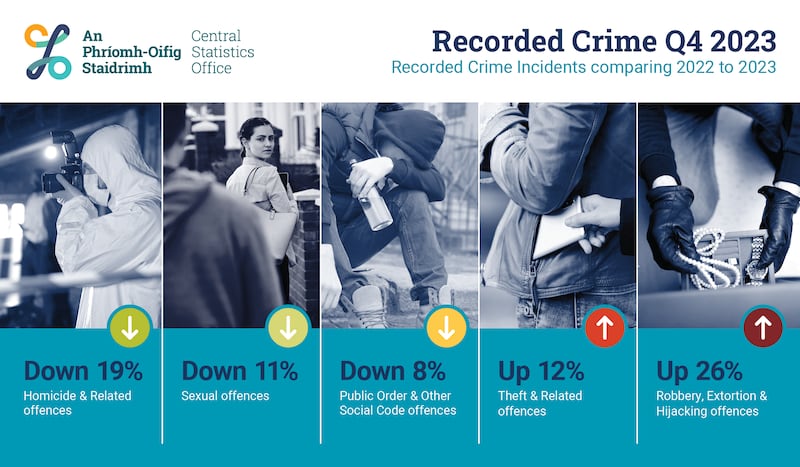The number of robberies, extortion and hijacking offences recorded in Ireland last year increased by more than a quarter, but the incidence of other crimes, including murders and sexual offences, fell, according to the latest data.
The Central Statistics Office (CSO) on Monday published final-quarter crime figures for last year, which showed the number of theft and related offences increased by 12 per cent to 74,144 incidents. Nearly half of these offences (46 per cent) were due to a growing number of thefts from shops.
Representative body Retail Excellence Ireland (REI) said “urgent action” was required to deal with the rise in crimes affecting its members.
“The statistics from the CSO back up what we’re hearing from our members on a daily basis; that the retail industry is increasingly being targeted by criminals across the country,” said REI chief executive Jean McCabe.
Kyran Durnin case: Tusla review completed but will not be published
Former HSE manager shared child sexual abuse images of ‘utmost depravity’ online, Mayo court hears
Businesswoman claims she has been threatened by man refusing to vacate house she purchased
Use of fireworks at Halloween widespread despite garda seizures worth €225,000 over 10 years
The number of robbery, extortion and hijacking offences recorded increased by 26 per cent to 2,601 between 2022 and last year.
The data also showed increases in weapons and explosives offences (up by 5 per cent); damage to property (3 per cent); and burglary and related offences (1 per cent).
The number of controlled drug offences recorded remained virtually unchanged year on year, the CSO said.
Homicide and related offences were down 19 per cent from 80 to 65 incidents over the year, mostly reflecting a fall in the number of murders recorded.

All other crime categories fell over the year with the highest rates of decrease being for sexual offences (down 11 per cent); public order and other “social code offences” (down 8 per cent); and dangerous or negligent acts (down 7 per cent).
The number of fraud, deception and related offences recorded fell by 3 per cent to 11,292.
The CSO noted the rate of burglary and fraud crimes remains quite different to before the Covid-19 pandemic.
The number of recorded burglary and related offences fell from 16,750 in 2019 to 10,884 in 2020. A further drop to 8,584 in 2021 coincided with ongoing public health restrictions.
“As restrictions were lifted, the number of incidents then rose to 9,465 in 2022. In 2023, there were 9,545 incidents but this was 43 per cent less than the levels recorded in 2019,” the CSO said.
The number of fraud, deception and related offences, at 11,292, was 43 per cent more than the 7,921 incidents in 2019. The number of recorded crimes in this category more than doubled between 2019 and 2021 to 17,124 before falling back to 11,689 in 2022.
In other categories, the largest changes between 2019 and last year related to offences against Government, justice procedures and organisation of crime, which fell by 21 per cent; controlled drug offences, down 19 per cent; and kidnapping and related offences, down 17 per cent.
Jim Dalton, a statistician in the CSO’s crime and criminal justice section, said the number of male crime victims fell by 4 per cent and female victims by 3 per cent.
“When you look at the profile of victims by age and sex, there was a mixed experience for male victims of different age groups,” he said.
“There were decreases in the number of victims under 18 years of age (down 14 per cent) and those between 45 and 59 years (down 8 per cent) and 18 to 29 years (down 4 per cent). However, the number of victims aged 60 years or more rose by 5 per cent while those aged 30-44 years went up by 1 per cent.”
The number of female victims of assault fell across all age groups, except for those aged 60 years or more, where there was an increase of 12 per cent. The highest rate of decrease was for those under 18 years of age, down 11 per cent.
- Listen to our Inside Politics Podcast for the latest analysis and chat
- Sign up for push alerts and have the best news, analysis and comment delivered directly to your phone
- Find The Irish Times on WhatsApp and stay up to date




